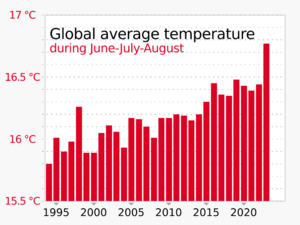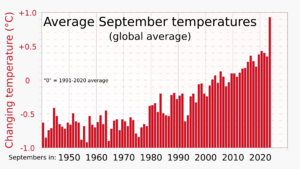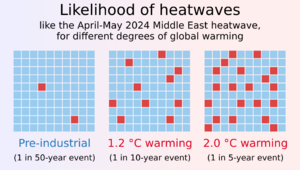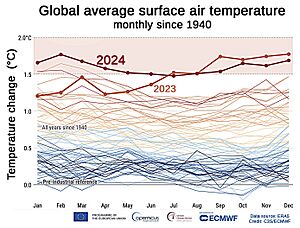List of heat waves facts for kids
Heat waves are periods of extremely hot weather that last for several days or even weeks. They can be very dangerous, causing health problems like heatstroke and making droughts and wildfires worse. Throughout history, many parts of the world have experienced severe heat waves, some of which have broken temperature records and led to serious consequences. This list highlights some of the most notable heat waves recorded.
Past Heat Waves
Before the 1900s
- 1540 European drought: Europe suffered an extreme drought and heat wave that lasted for 11 months.
- July 1743 heat wave in China: Beijing reached a scorching 44.4 °C (111.9 °F) (about 112°F). Sadly, 11,400 people were reported to have died.
- July 1757 heat wave: This was Europe's hottest summer since 1540 and remained so until 2003.
- 1896 Eastern North America heat wave: This event in August 1896 caused the deaths of 1,500 people.
- 1900 Argentina heat wave: Known as "the week of fire," this heat wave in early February affected Buenos Aires and Rosario. Temperatures reached 37 °C (99 °F) (99°F), but felt like 49 °C (120 °F) (120°F) due to high humidity. At least 478 people died.
The 1900s
- 1901 Eastern United States heat wave: This heat wave tragically killed 9,500 people in the Eastern United States.
- 1911 heat waves:
* In the Eastern North America, a heat wave killed between 380 and 2,000 people. * The United Kingdom experienced one of its most severe heat waves, with temperatures around 36 °C (97 °F) (97°F). It lasted from early July to mid-September. * In France, 41,072 deaths were reported during a heat wave.
- 1913 California heat wave: In July, Death Valley recorded a record high temperature of 57 °C (134 °F) (56.7°C) at Furnace Creek. This is still the highest air temperature ever recorded on Earth.
- 1923–1924 Marble Bar heat: The Australian town of Marble Bar had 160 days in a row where temperatures reached 38 °C (100 °F) (37.8°C) or higher.
- 1930s Dust Bowl heat waves: Almost every year from 1930 to 1938, North America saw historic heat waves and droughts. This was part of the difficult Dust Bowl years.
* In 1936, massive heat waves hit North America, following one of the coldest winters. * Yuma, Arizona, had 101 consecutive days of 38 °C (100 °F) (37.8°C) or higher temperatures in 1937.
- 1950s United States heat waves: A long and severe drought and heat wave hit the central and southern United States in the early 1950s. Major heat waves occurred every year from 1952 to 1955.
* In 1954, temperatures exceeded 38 °C (100 °F) (37.8°C) for 22 days in many states. * East St. Louis, Illinois, reached 47 °C (117 °F) (47.2°C) on July 14, 1954, which is still the highest temperature for that state.
- 1960 Oodnadatta heat: On January 2, Oodnadatta, South Australia, reached 50.7 °C (123.3 °F) (123.3°F). This is the highest temperature ever recorded in the Southern Hemisphere and Oceania.
- 1972 New York heat wave: Almost 900 people died during a 16-day heat wave in New York and the Northeastern United States. High humidity made it even worse.
- 1976 United Kingdom heat wave: This was one of the hottest heat waves in memory, with temperatures over 32 °C (90 °F) (90°F) for more than two weeks. It also caused one of the worst droughts in British history.
- 1980 United States heat wave: An estimated 1,000 people died during this heat wave and drought in the central and eastern United States.
* Dallas/Fort Worth had 42 days in a row with temperatures above 38 °C (100 °F) (37.8°C). * Wichita Falls, Texas, reached 47 °C (117 °F) (47.2°C) on June 28.
- 1988 United States heat wave: Intense heat and drought caused many deaths across the United States. Official estimates suggest 5,000 to 10,000 people died.
- 1995 Chicago heat wave: This event caused record high heat and humidity in the Chicago area. At least 778 people died, mostly in lower-income neighborhoods.
- 1999 Eastern United States heat wave: A heat wave and drought in the summer of 1999 led to 502 deaths across the country.
The 2000s
- 2001 Eastern North America heat wave: In early August, an intense heat wave hit the eastern United States and Canada. Temperatures climbed above 35 °C (95 °F) (95°F) with high humidity.
- 2003 European heat wave: This heat wave affected much of western Europe, breaking temperature records. In France, nearly 15,000 people died. Portugal saw temperatures as high as 47 °C (117 °F) (116.6°F).
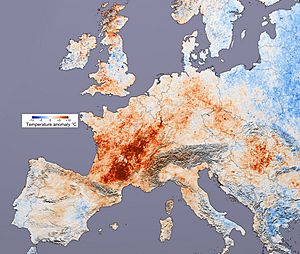
- 2006 European heat wave: This was the second major heat wave in Europe in four years. Many heat records were broken, and July 2006 became the hottest month ever recorded in the UK.
- 2006 North American heat wave: This heat wave affected a large part of the United States and Canada. Over 220 deaths were reported. California experienced extremely high temperatures, with Los Angeles County recording its highest temperature ever at 48 °C (119 °F) (48.3°C).

- 2007 European heat wave: This heat wave mainly affected southeastern Europe. Bulgaria had its hottest year on record, with temperatures above 45 °C (113 °F) (113°F).
- Early 2009 southeastern Australia heat wave: Adelaide, South Australia, had temperatures over 40 °C (104 °F) (104°F) for six days in a row. Melbourne, Victoria, recorded its highest ever temperature at 46.4 °C (115.5 °F) (115.5°F). This heat wave contributed to large bushfires that killed 173 people.
- August 2009 Argentine winter heat wave: Argentina experienced unusually hot weather during its winter. Buenos Aires reached 34.6 °C (94.3 °F) (94.3°F), making it the hottest winter day ever recorded there.
The 2010s
- 2010 Northern Hemisphere summer heat wave: This heat wave affected many areas, especially parts of China and European Russia.
* In May, Mohenjo-daro, Pakistan, set a national record high of 53.5 °C (128.3 °F) (128.3°F). * In July, the American East Coast saw severe heat. Philadelphia, New York, and Washington, D.C., all went above 38 °C (100 °F) (37.8°C).
- 2011 North American heat wave: This brought record heat to the Midwestern United States, Eastern Canada, and the Eastern Seaboard.
- 2011 Southwestern Asia heat wave: Temperatures in Iraq exceeded 49 °C (120 °F) (49°C) in late July and early August. Baghdad reached 51 °C (124 °F) (51.1°C).
- 2012 North American heat waves:
* In March, the Midwest experienced one of the largest heat waves ever. * In late June, much of North America had a heat wave. This led to violent storms that caused widespread power outages.
- 2012–2013 Australian "Angry Summer": This summer resulted in 123 weather records being broken. It included the hottest day ever recorded for Australia as a whole.
* From December 2012 to January 2013, a large part of Australia recorded temperatures above 40 to 45 °C (104 to 113 °F) (104-113°F). This extreme heat caused a "flash" drought and massive wildfires.
- 2013 Southwestern United States heat wave: In late June, an intense heat wave hit the Southwestern United States. Death Valley, California, reached 54.0 °C (129.2 °F) (54°C), the hottest temperature ever recorded on Earth during June.
- 2013 China heat wave: From July to August, southern China experienced an unusually severe heat wave. Many areas had temperatures over 40°C (104°F) for a long time. Hangzhou had 14 days in a row over 40 °C (104 °F) (104°F).
- 2013 Argentina heat wave: This was the longest heat wave in Argentina since records began in 1906, lasting 22 days from December 2013 to January 2014. It severely affected the health of thousands of people, causing at least 1,877 deaths.
- 2015 India heat wave: Between April and May 2015, a heat wave in India killed more than 2,200 people. Temperatures were between 45 and 47 °C (113 and 117 °F) (113-117°F).
- 2015 Pakistani heat wave: Starting in June 2015, a severe heat wave killed more than 2,500 people in Karachi, Pakistan.
- 2015 European heat wave: From late June to mid-September, unusual and long-lasting heat waves occurred across Europe. Temperatures went above 40 °C (104 °F) (104°F) in many places.
- 2016 Arizona and California heat: In June 2016, record heat appeared in Arizona and southern California. Blythe, California, set a new all-time record high of 51 °C (124 °F) (51.1°C).
- 2016 Kuwait and Iraq heat: In July 2016, Mitribah, Kuwait, reached 54 °C (129 °F) (129.2°F), and Basra, Iraq, reached 53.9 °C (129.0 °F) (129°F). These are some of the highest temperatures ever recorded outside of Death Valley.
- 2016 Indian heat wave: This record heat wave in April and May 2016 saw a national record high of 51.0 °C (123.8 °F) (123.8°F) in Phalodi, Rajasthan. Over 160 people died, and 330 million were affected.
- 2017 Chile heat wave: From January 25 to 27, Chile experienced intense heat. Quillón recorded 44.9 °C (112.8 °F) (112.8°F), the highest temperature ever recorded nationwide.
- 2017 Iran heat wave: In June 2017, a heat wave in Iran broke record high temperatures. Ahvaz soared to 54 °C (129.2 °F) (129.2°F), and with humidity, the heat index felt like 61 °C (142 °F) (141.8°F).
- 2018 British Isles heat wave: This heat wave affected the UK and Ireland from April to August. Many areas saw temperatures exceed 30°C (86°F) for many days.
- 2018 North American heat wave: This heat wave started in Mexico in late May. By July, it caused about 74 deaths in Quebec, Canada.
- 2018 Japan heat wave: In mid-July, a heat wave in Japan caused over 22,000 hospitalizations and 80 deaths.
- 2019 Australian heat wave: From December 2018, Australia faced constant record-breaking heat waves. Adelaide recorded its hottest day ever on January 24, reaching 46.6 °C (115.9 °F) (115.9°F). Melbourne had its hottest January or February day at 43 °C (109.4 °F) (109.4°F).
- 2019 Indo-Pakistani heat wave: This heat wave reached a near record high of 50.8 °C (123.4 °F) (123.4°F) in Churu, India. Dozens of deaths were reported.
- 2019 European heat wave: Starting in June, very hot air from the Sahara desert moved over Europe, leading to heat warnings. France broke its old national record of 44.1 °C (111.4 °F) (111.4°F). Later, new national heat records were set in the Netherlands, Belgium, Luxembourg, Germany, and the United Kingdom.
The 2020s
- 2020 Australian heat: On January 4, Canberra and Penrith in Australia broke their all-time records, reaching 44.0 °C (111.2 °F) (111.2°F) and 48.9 °C (120.0 °F) (120°F) respectively. Penrith was the hottest place on Earth that day.
- 2020 Siberia heat wave: A heat wave in Siberia set an all-time record high in Verkhoyansk on June 20, reaching 38 °C (100 °F) (100.4°F). This was possibly the hottest temperature ever recorded so far north in the Arctic.
- 2020 United Kingdom heat wave: After a cool July, temperatures soared to 37.8 °C (100.0 °F) (100°F) at London Heathrow Airport on July 31. This was the fifth hottest temperature on record for the UK.
- 2020 Western United States heat: Death Valley reached 54.4 °C (129.9 °F) (54.4°C) on August 16, one of the highest temperatures ever recorded on Earth.
- 2021 Winter heat wave in Europe and Asia: In mid-February, a jet stream of Sahara dust brought unusually warm winter temperatures to Europe. Berlin reached 20 °C (68 °F) (68°F). Beijing, Asia, declared a record-high winter temperature of 25.6 °C (78.1 °F) (78.1°F).
- 2021 Russia heat wave: This heat wave and drought caused severe wildfires in Siberia.
- 2021 Western North America heat wave: In late June, this heat wave caused temperatures to soar above 38 °C (100 °F) (100°F) in the Pacific Northwest. All-time record high temperatures were set in Portland, Oregon (47 °C (116 °F) / 46.7°C) and Seattle (42 °C (108 °F) / 42.2°C). Lytton, British Columbia, reached 49.6 °C (121.3 °F) (121.3°F), the highest temperature ever recorded in Canada.
- 2021 Mediterranean heat wave: In the last week of July, a heat wave began in Turkey, Greece, Italy, and other countries. On August 11, 48.8 °C (119.8 °F) (119.8°F), the highest temperature ever in Europe, was recorded in Floridia, Sicily.
- 2022 South America heat wave: In mid-January 2022, Argentina, parts of Brazil, Paraguay, and Uruguay experienced a record-breaking heat wave, with temperatures over 44 °C (111 °F) (111.2°F).
- 2022 India heat wave: Starting in late March 2022, India began experiencing one of its hottest March–April periods on record.
- 2022 United States heat wave: A major heat wave affected the United States throughout May. In mid-June, a record-breaking heat wave affected half of the United States. St. Louis reached a record-tying temperature of 38 °C (101 °F) (38.3°C).
- 2022 Japan heat wave: In late June 2022, Japan saw its worst heat wave in 150 years.
- 2022 European heat waves: These heat waves affected much of Western Europe and the United Kingdom. Temperatures in Spain reached 45.7 °C (114.3 °F) (114.3°F). The UK issued its first-ever red extreme heat warning, and temperatures reached 40.3 °C (104.5 °F) (104.5°F) at Coningsby on July 19, the first time the UK exceeded 40°C.
- 2023 Asia heat wave: In mid-April 2023, heat waves occurred in several countries in South Asia and Southeast Asia. Luang Prabang, Laos, reached 42.7 °C (108.9 °F) (108.9°F), the highest in Laos' recorded history. Vietnam recorded its highest ever temperature of 44.1 °C (111.4 °F) (111.4°F) in May.
- 2023 European heat waves: Starting on July 10, 2023, a record-breaking heat wave, named "Cerberus," affected many European countries, especially Greece, Italy, and Spain. A new heat wave in the third week of July was called "Charon." In September 2023, much of western Europe experienced unusually high temperatures. The UK recorded seven days in a row above 30.2 °C (86.4 °F) (86.4°F). Paris recorded 36.5 °C (97.7 °F) (97.7°F), a new all-time record for September.
- 2024 North America heat waves: Since March 2024, severe heat waves impacted Mexico, the Southern United States, and Central America. This led to many broken temperature records, mass animal deaths, water shortages, and increased forest fires.
- 2024 Southeast Asia heat wave: Since April 2024, Southeast Asia has faced a severe heat wave, with temperatures up to 38.8 °C (101.8 °F) (101.8°F). This caused school closures and health warnings.
- 2024 Indian heat wave: Since May 2024, the longest heat wave occurred in India and Pakistan. New Delhi reached a new record of 49 °C (120 °F) (120.2°F), and temperatures in Pakistan reached 52.2 °C (126.0 °F) (126°F).
- 2024 European heat waves: Since mid-June 2024, Greece has been experiencing a heat wave, with temperatures forecast to reach 43 °C (109 °F) (109.4°F). Turkey was also affected, with temperatures hitting 44 °C (111 °F) (111.2°F).
- 2024 Hajj extreme heat disaster: In mid-June 2024, high temperatures in Mecca, Saudi Arabia, led to the deaths of many pilgrims during the Hajj. It was reported that as many as 1300 people may have died.
- 2024 Japan heat waves: At least 59 heat-related deaths were recorded in Japan. The average temperatures during these heat waves were the hottest for Japan in April and July since record-keeping began in 1898.
- 2025 Australia heat wave: In January 2025, a heat wave struck much of Australia. Melbourne reached 41°C (105.8°F), and fire bans were issued for Victoria.
- 2025 United States and Canada heat wave: In May 2025, a heat wave occurred across much of the United States and parts of Canada. Del Rio, Texas, reached a record high of 109 °F (43 °C) (42.8°C) on May 13, 2025.
See Also
- List of named heat waves
- List of cold waves
- List of Indian heat waves
- List of marine heat waves
- List of severe weather phenomena






